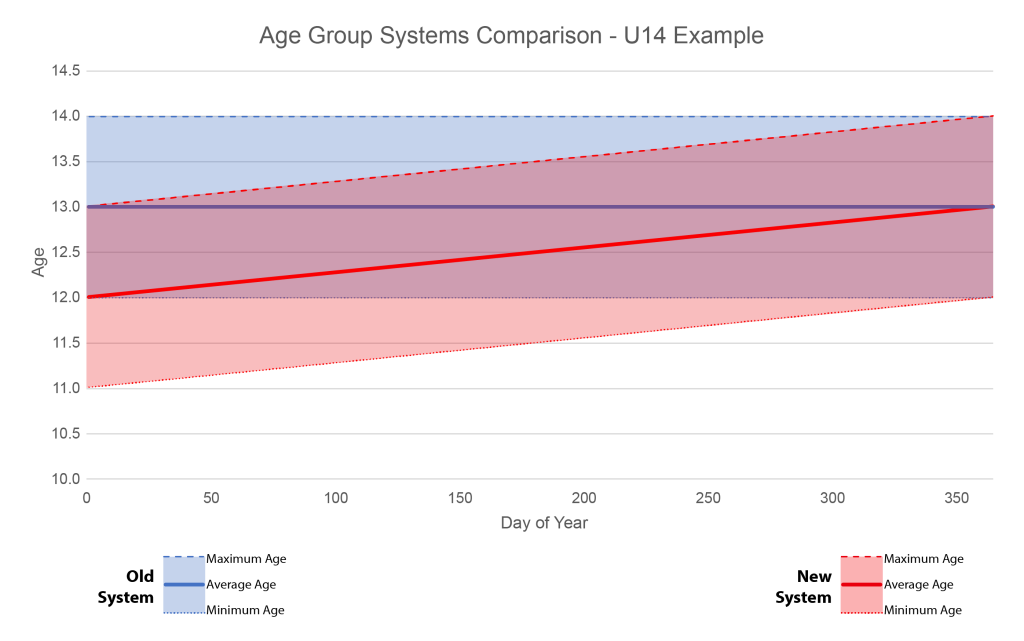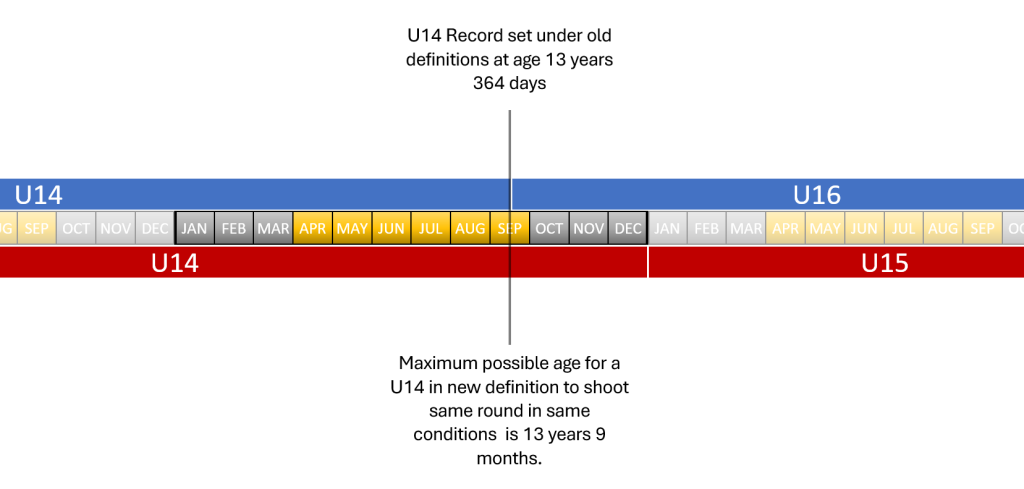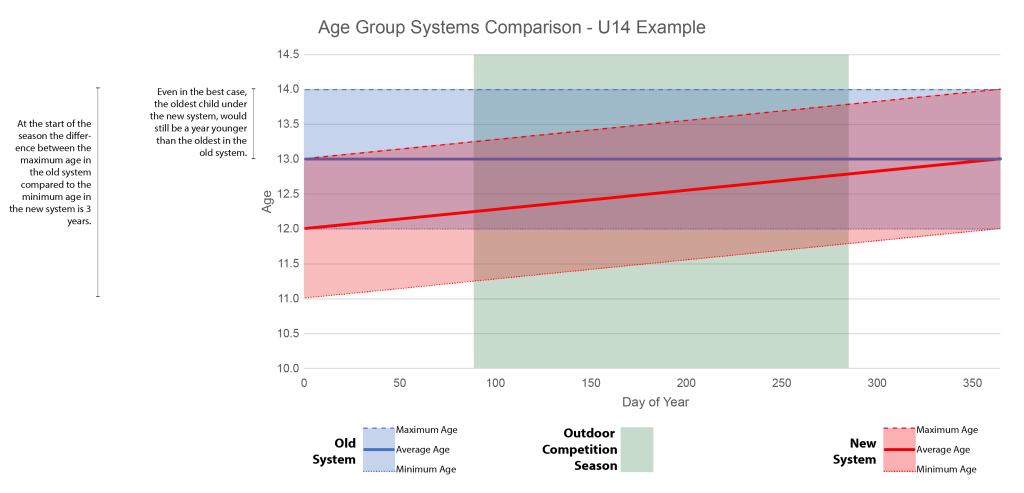As I’ve written about before, in October 2023 ArcheryGB made some quite significant changes to the age groups for target archery in the UK. This included adding some new groups (50+, U21, and U15), and also crucially, changing the definition of how age groups are even defined. So, even for the age groups that don’t look like they’ve changed because they have the same names as the old ones (U12, U14, U16, U18), something significant has actually changed, and this post will look at what that means in practice.
With the 2022 age-group changes, ArcheryGB adopted the World Archery definition of age. In this new system, your age is no longer defined by your birthday but defined by your birth year. So, in the previous system where an Under 12 archer would have moved up to Under-14s immediately on their 12th birthday, they would now compete in the U12s group up to the 31st December on the year of their 11th birthday, and would move up to the U14s the next day (Jan 1st).
This may not sound like a massive change, but it has some interesting statistical effects that we will look at here, and opens up an important question about whether records shot under the old definitions are compatible with the new definitions.
Birthday vs Birth year – What difference does it make?
When comparing different ways of representing age, it’s useful to think about a few key statistics – specifically, the youngest someone can be in an age group, the oldest they could be, and the average age of people within a group. In the old system, where age was defined by your birthday, it’s pretty simple (let’s use the Under-14 age group as an example).
- Minimum age of a U14 – 12 years and 0 days
- Average age of a U14 – 13 years
- Maximum age of a U14 – 13 years 364 days (let’s ignore leap years for now)
Now, let’s look at the new WA-style system for the same U14 age group. This one is more complicated because it depends on when we’re asking the question – the answers will be different at different points in the year.
- Minimum age of a U14 – 11 years and 0 days (their 13th birthday is on the 1st Jan and that’s when we’re looking)
- Average age of a U14 – It changes throughout the year, but on average that average is 12.5
- Maximum age of a U14 – 13 years 364 days (their birthday is on 31st Dec)
We can look at these two systems graphically, as shown below. We need to look over a whole year though as the minimum, maximum and average in the new system change depending on where you are in the calendar. At first glance, the gap between the minimum and maximum might make you think that the age group covers 3 years rather than 2, but that’s not the case because we’re looking at different points in time. The kid with a birthday on 1st Jan will be exactly 11-years and 0-days old on that day, but the oldest person they might find themselves competing against when they’re that age has just turned 13 the day before (31st Dec), so they’re separated by only 2 years (and one day). This maximum gap in the ages of competitors on the same day, is the same as in the old system. You can see this on the chart below – the minimum and maximum of the new red band are always the same distance apart on a given date.

This chart is interesting as it shows what our intuition would expect. The old system is a constant blue bar across, with minimum, average and maximum not depending on where we are in the year. The new system, with its cliff-edge at the end of the year starts lower, but by the end of the year has caught up. If you’re running a competition on New Year’s Eve, the new and old age group systems are basically the same!
The averages tell us one of the most important facts though – the average age in the U14s group is now 6 months younger than it was under the old definition of the age group. Children develop fast, so 6 months is quite a big difference at that age. Of course, this same pattern holds true for all age groups – shifting to a birth year rather than a birth-day definition means that the average age of competitors in each age group is 6 months younger on average than it previously was, so the age categories, by definition, don’t mean the same thing that they used to.
What this means for records
In changing the definition of age, it also raises the question of how we should handle other things that are based on age, and how compatible they are with the new system. The prime example of this is records (It’s doesn’t particularly matter whether we’re talking about national, regional, county or club records, so I’ll just say “records” from now on). In their announcement of the new age groups, ArcheryGB said that –
All current records will continue to stand
ArcheryGB – ArcheryUK magazine, summer 2022
So, even though we’ve changed the definition of what it means to be an Under-14 (for example), those kids are still trying to break records set by people who were using the old definition of what it meant to be a U14. Purely looking at the averages alone, this is a bit of a concern, as the average age of children the U14 category is now 6 months lower than it used to be. Performance and age are correlated quite tightly, so it would be safe to assume that scores in the newly defined age group will be generally lower than they were in the old U14 age group.
In practice this might mean that records in these categories may have been set by someone who would no longer qualify to even be in that category. For example, imagine someone in the old system who set a U14 record when they were right at the top of that age bracket (13 years 364 days) in the peak of the outdoor competition season in and in the period of the best shooting conditions in August. Under the new definition, that person would no longer qualify to be an Under 14. They would have moved up to the next age group 8 months earlier in January. Worse than that, we now have a situation where no Under 14 will ever be that old again during the peak of the outdoor competition season – the oldest kids in the U14 category will have January birthdays and be 13 years 8 months old during that same period in August. In reality, there are outdoor competitions in the UK in September too, so there is a chance that a 13-year and 9-month old might get a chance to break the record set by the 13-year and 364-day old, but it’s a pretty slim chance.

At the other end of the year, it’s even more extreme. The gap between how old the kids were in the old age group definitions and how old they are in the new system are enormous. In the best case, the gap is still a year – the oldest new-definition U14 would be a year younger in a January event that the oldest old-definition U14. In worst case, we have a 3 year age gap – the kids at the bottom of the new-definition U14 group might be trying to break records set by someone 3 years their senior.

Is there really a problem, and if so, what’s the solution?
I’ve used the words “if” and “might be” a lot during this article so far, talking about theoretical scenarios where records that are currently on the books might be unbeatable. There are two issues key with retaining current records
- Some records currently on the books will have been set by people who would no longer meet the definition to be included in that category.
- Some records may have been set in situations/conditions that will never be available to competitors in the future (in terms of timing of seasons when certain rounds are typically shot, and the good weather conditions that go with them).
The key question is how widespread those issues are, and whether there are enough of them to invalidate the whole records system. Unfortunately, the only way to know for certain is to painstakingly analyse, for each record
- What was the archer’s date of birth, and therefore how old, exactly, were they on the day the record was shot?
- Would they still be eligible to be in that age category now?
Unfortunately, that requires knowing the date of birth for every record holder, and as is rightly the case, that information is not easily accessible. ArcheryGB could probably do it for national records as they have that information on their membership files. Club records officers could do it for their club records as they also know the dates of births of the record holders. Organisations in between like Counties and Regions have little hope of ever getting access to the required data to do this.
To me, there are 3 possible ways to go with this situation
- Do the painstaking manual analysis to find out if each record would still be valid given the new definitions of the age-groups, and archive and reset any that would not be valid.
- Archive all of the current records, and create a clean slate for records in the newly defined categories. This would definitely be an “archive” rather than a “wipe”. All previous records would be set in stone and stored separately, and a fresh era would start with a clean slate.
- Keep all the current records, accepting the fact that they may include a certain unknown proportion that are not valid, and run the risk that the whole system is tainted because of this.
None of these options are good.
- The manual analysis is probably impossible to do reliably, and we’d never be certain whether we’d caught everything.
- Archiving all the records would correctly remove some invalid records, but might also take with it many records that would be valid in the new definitions. The awarding bodies would be inundated with angry emails from people (or more likely their parents) whose records had been removed from the record books.
- Keeping all the current records means that every future generation of children will be trying to beat records that are probably unbeatable, because they were set by kids who were older than anyone in that age group ever will be again, shooting a round at a time of the year that people now of that age won’t get to. The awarding bodies will be inundated with phone calls from people (parents) who complain that it’s unfair that the record in their category was set by someone who wouldn’t have been eligible given the current definitions, and they’d be correct.
Maybe there could also be some sort of hybrid approach where all current records are archived, but retrospective record claims are allowed so that people can re-submit record claims where they meet the definitions of the new category? That would be a lot of work to administer, but maybe provides a way to strike the right balance?
My personal opinion is that the least bad option is to archive all the current records. The definitions of the categories that those records belong to has changed enough that they don’t mean the same thing any more. In some sense this is no different a theoretical scenario where we decided that Recurve bows could now use telescopic sights – would we keep the same records? Of course not, because the category doesn’t mean the same thing anymore, even though it might have the same name.
In fact, the naming of the categories is part of the problem here. The fact that the old age group names (U12, U14, U16 etc.) share the same labels as the new ones (also called U12, U14, U16 etc.) it makes us believe they’re the same thing and so the records should remain. I can’t help feeling that if the new age categories had non-numeric names (Junior, Cadet, Cub, etc.) then we wouldn’t be having this debate. Everyone would recognise that because of the way that they were defined they are fundamentally different than what went before, and so should start with a clean slate.
I keep coming back to the fact that the average age of kids in each age group is half a year younger. These are not the same cohort of kids that previously went under that same label. It would be the same as changing our school year to start from January rather than September and then wondering why this years Year 5’s didn’t have the same average test score as last year’s Year 5. If you redefine what the category is, you can’t use the same comparisons, benchmarks or records as you did under the old definition.
How is this handled in other sports?
There are a few anecdotal examples in other sports of similar situations

https://commons.wikimedia.org/wiki/File:Bundesarchiv_Bild_183-1984-0513-018,_Uwe_Hohn.jpg
In the early 1980s, the Javellin event was going through a difficult period. Javellins were being thrown further and further, often getting dangerously close to the crowd, and were also landing flat and skidding rather than sticking in the ground. In 1986, a new design for Javellins was introduced, which moved the centre of mass forward 40mm, and blunted the tip to make it less aerodynamic. At this point, the event of Javellin was no longer the same as it previously was, so the previous records were archived, and new records were started with a clean slate from that point. The old records were not deleted, merely archived, and can still be found in lists of all-time longest throws.
In 2017, the European Athletics Federation proposed a plan to the IAAF to reset all athletics records prior to 2005. In their case, the reason was to address the fact there were an unknown number of unbeatable world records on the books which were tainted by possible doping, and before 2005, the frameworks didn’t exist to confidently assert the validity of records. Ultimately, those proposals didn’t proceed, mainly because of a backlash from existing record holders. Interestingly, the debate centered around the same issues shown above – the risk of inadvertently removing valid records during in an attempt to remove the bad ones.
In 2018, World Para Athletics changed the maximum allowable standing height (MASH) for double leg amputee athletes in the T43/F43 and T42/F42 classes, after longer blades were found to be giving an unfair advantage . After these class definitions were changed, all records before 2018 were archived and there was a clean slate in that category.
There are many more of these – shortening of pole-vault pegs, tech-suits in swimming, and many more, and there’s a mix of different outcomes. Please add a comment below if you know of others.
So what should we do?
There is no easy answer to this question. All options are wrong in one way or another. We need to choose between two types on wrongness –
- Technically wrong, in that they would leave records on the books that are invalid – records which would not qualify if they were shot today by that same person at the same age if they shot it now.
- Ruthlessly wrong, in that it might take away a record that is technically still valid.
ArcheryGB’s decision is that records should stand, which to me is technically wrong. I think if I had to choose, I would go for the ruthlessly wrong approach, which would at least mean that all records from this point forward would be correct, and not tainted by the perception that they might have been unfairly set by under a previous definition of the category.
Maybe I would feel differently if it was one of my records, or my childrens’ records that was being archived? However, we must be clear that this is an archiving of scores – they wouldn’t be “deleted” or “reset”, quite the opposite in fact – those records would be set in stone forever, never to be challenged against and always listed in the record books.
This is clearly an emotive topic, with no universally right answer. I’d be interested to hear other people’s views in the comments below, but as with all emotive topics, please keep it civilised…
Leave a Reply